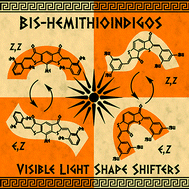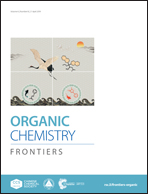Symmetric and nonsymmetric bis-hemithioindigos – precise visible light controlled shape-shifters†
Abstract
Multiphotochromic switches represent an important class of responsive molecular entities enabling higher levels of control over geometries, functions, and related properties at the nanoscale. However, combining several photoswitches within the same molecular setup requires careful design in order to prohibit unfavorable quenching processes that limit or even shut down the photoswitching capabilities. Here we represent a series of bis-hemithioindigo photoswitches combining two hemithioindigo moieties either in a symmetric or nonsymmetric fashion within the same molecule. In either case a fully planar and a structure with highly twisted periferal molecular fragments was scrutinized with respect to conformation in the crystalline state or in solution and with respect to the photoisomerization behavior. Highly selective and reversible photoisomerizations were found between two of either three or four possible isomeric states in each case, which are achieved entirely by visible light irradiation. This behavior enables precise and effective control over large geometrical changes in these photoswitches. Additionally it could be shown that twisting in the periphery of the molecule notably improves the photoswitching performance and enables greater E isomeric content although no alteration in the electronic communication between the switching units is present.

- This article is part of the themed collection: In celebration of Julius Rebek’s 75th Birthday


 Please wait while we load your content...
Please wait while we load your content...